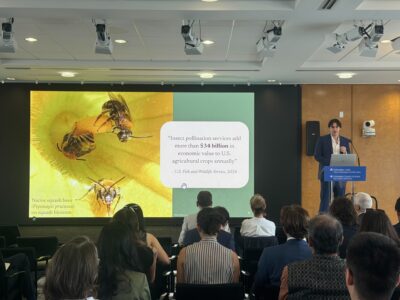By Aurora Barone
On June 24, graduate students pursuing a Master of Public Administration in Environmental Science and Policy met with scientific researchers at the Lamont-Doherty Earth Observatory to explore how scientific research converges with public policy.
As the largest research unit of Columbia University’s Earth Institute, the Lamont-Doherty Earth Observatory houses nearly 200 PhD-level researchers who study the planet from its core to its atmosphere. These researchers first mapped the ocean floor, proving plate tectonics and continental drift a reality. They helped map global ocean circulation and predicted an imminent rise in the Earth’s temperature due to carbon-intensive human activity nearly 45 years ago, coining the phrase ‘global warming’. They discovered that ice ages are linked to Earth’s orbital changes and developed models to predict El Niño events. Scientists at Lamont have changed the way we understand the natural world and continue to drive this change through their ongoing innovative work.
As part of the Master of Public Administration in Environmental Science and Policy, students undertake science courses in the summer that will serve as a foundational basis for tackling environmental issues and policy in later semesters as well as their careers. Who better to learn from than the individuals who dominate current research in the earth sciences?

Jason Smerdon presented students with an overview of his research on the linkages between climate change and megadroughts, while Róisín Commane discussed the impact that greenhouse gas emissions have on New York City’s air quality. Joaqium Goes, who was recently featured in Columbia Magazine for his work on microplastics in New York City waterways, delved into the battleground of natural and human-made climate change hardships emerging in regions near the Arabian Sea.
The students toured on-site research laboratories, led by the scientists who oversee these very labs. The public policy students gained perspective into how scientists conduct their work. They were able to question scientists directly about new research developments and their views on how their research could inform public policy.
Effective environmental policy hinges on a solid understanding of the science that backs it. Over the course of the one-year master’s program, these students will gain an understanding of how earth systems function, such as the Earth’s climate. They will also acquire skillsets that allow them to communicate and transform complex scientific concepts into actionable policies that can help mitigate or resolve the pressing issues that we face. This excursion to the Lamont-Doherty Earth Observatory helped to bring scientists and future policymakers together in the hope that we may find and effectuate science-driven solutions by embracing our strongest weapon in the fight to preserve our planet: education.
Aurora Barone graduated in May 2019 with a Master of Public Administration in Environmental Science and Policy. She currently works as a research assistant with the Earth Institute focusing on impact investments in emerging markets.



